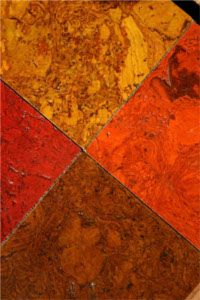
Cork kitchen tiles are obtained from the bark of the cork oak tree widely available in the Mediterranean countries, particularly in Spain and Portugal. The average lifespan of this tree is around 500 years. The bark of these trees are stripped (without cutting the trees or damaging the inner layers of the bark) after every 10 to 15 years and is used for making the cork tiles. Thus, it is derived from a renewable source. For this reason, cork kitchen flooring is considered as one of the most environment friendly flooring materials.
Benefits of Cork Flooring
The unique properties of cork flooring is due to its structural composition which is rarely found in other naturally occurring substances. It has a cellular structure that enables it to trap 90 percent air or gas inside it. As a result, it can be compressed to 40 percent of its volume and can regain its original shape. Thus, it can provide a soft, shock absorbing feel when you are standing in the kitchen for long hours. For the same reason, cork flooring can absorb noise and vibration to a great extent. So the impact of dropping of things on the kitchen floor will create less amount of noise.
The presence of a waxy substance in cork named suberin protects it from infestation of different species of insects like termites and the growth of mold. The same waxy substance makes cork impermeable to gas or liquid. Thus, it does not cause rotting even if the surface of the floor remain wet for a long time. It has natural resistance towards fire and it does not release any toxic gases when it burns. Due to all these qualities, cork kitchen tiles are highly durable in nature.
Installation
One of the key reason behind the popularity of cork kitchen flooring is that it is easy to install. Before installing the flooring, you have to clear all the furniture, kitchen appliances and carpet from the kitchen floor, clean up the dust and dirt and allow it to dry thoroughly. Make sure that the surface of the floor is even and flat. In case, there are some imperfections, level them with the help of floor patch.
Cork tile flooring is a floating floor and can be installed on any kind of subfloor that has a hard surface. It could be wood, other types of flooring such as vinyl or ceramic or even concrete. Like any other naturally occurring product, cork tends to undergo expansion and contraction in different climatic conditions. For this reason, acclimatization of the cork tiles for a specific period of time is a must. Usually, the time required for this varies from 24 to 72 hours. It is recommended to read the manufacturer's instructions and acclimate it according to it.
Once the cork panels are acclimatized, you should lay the panels on the subfloor. The planks are designed in such a manner that the edge of one plank gets interlocked with the edge of the adjacent one. When you reach the border of the floor make sure that you keep some gap there for purpose of expansion and contraction of the cork floor. Finally, apply glue to the joints of the newly installed planks. This is essential for a kitchen floor as it is exposed to a lot of liquid spills. If the joints are not properly sealed then the liquid may flow down the surface of the cork through these joints.
The fresh, natural feel of a cork kitchen flooring can add a lot of warmth and visual appeal to your kitchen decor. However, there are some disadvantages of this kind of flooring. It tends to fade out on exposure to sunlight and hence care should be taken to prevent it from fading. It can get dents if heavy kitchen appliances are placed on it. So provide enough padding on those areas to minimize their impact.





